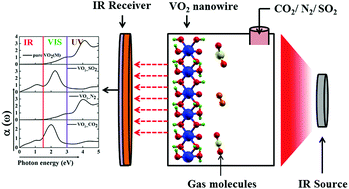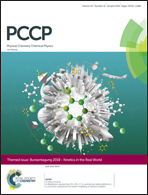Highly infrared sensitive VO2 nanowires for a nano-optical device†
Abstract
Recent studies on the electronic, magnetic and optical properties of VO2 (vanadium dioxide) materials have motivated the exploration of one dimensional VO2 nanowires. First principles calculations were performed to investigate the structural, electronic, magnetic and optical properties of the monoclinic (M) and rutile (R) phases of VO2 nanowires. The monoclinic phase shows semiconducting behaviour with a band gap of 1.17 eV, whereas the rutile phase of VO2 nanowires behaves as a spin gapless semiconducting material, as band lines cross the Fermi level due only to up spin contribution. The monoclinic structure of VO2 nanowires is found to be paramagnetic and the rutile structure shows ferromagnetic half metal behavior. The conductivity calculation for VO2 nanowires shows the metal–insulator transition (MIT) temperature to be 250 K. The possible mechanism of VO2 nanowires to be used as smart windows has been discussed, as the nanowires are highly sensitive in the infrared (IR) region. Interestingly, at low temperature, the VO2 monoclinic structure allows infrared light to be transmitted, while VO2 with the rutile phase blocks light in the IR region. Furthermore, we adsorbed CO2, N2 and SO2 gas molecules on 1D VO2 monoclinic nanowire to investigate their interaction behaviour. It was observed that the absorption and transmission properties of VO2 dramatically change upon the adsorption of CO2 and SO2 gas molecules, which is likely to open up its application as an optical gas sensor.



 Please wait while we load your content...
Please wait while we load your content...